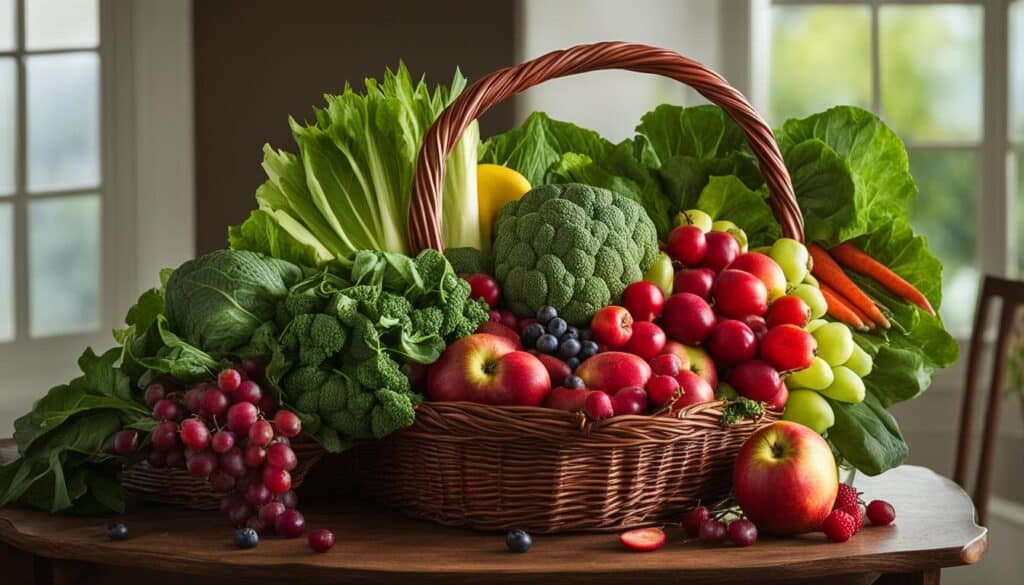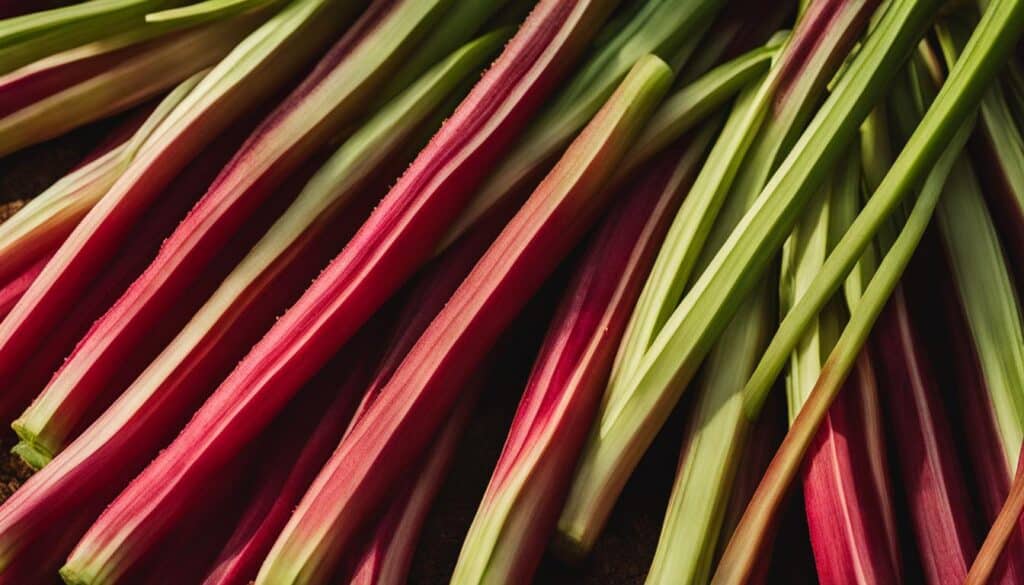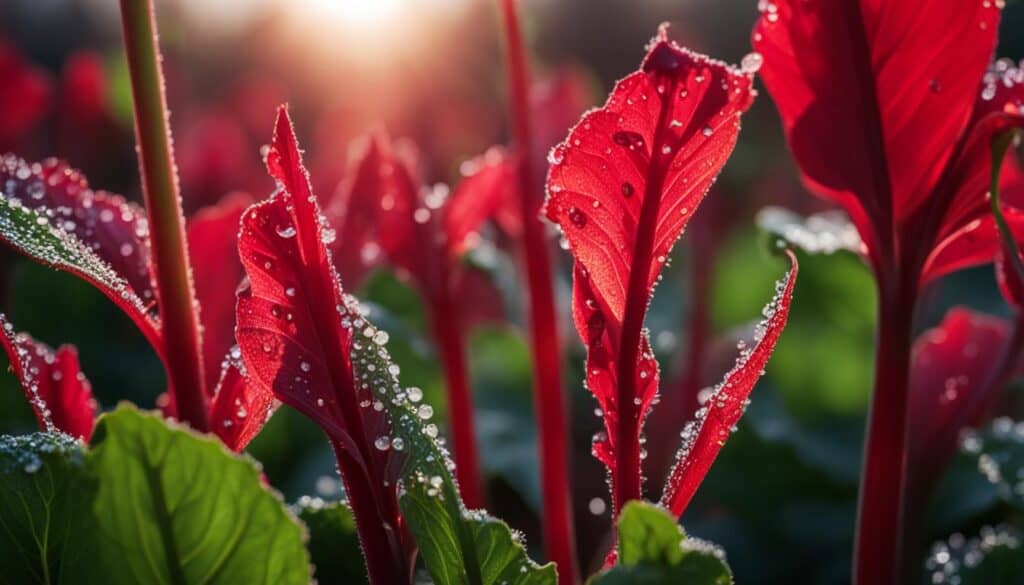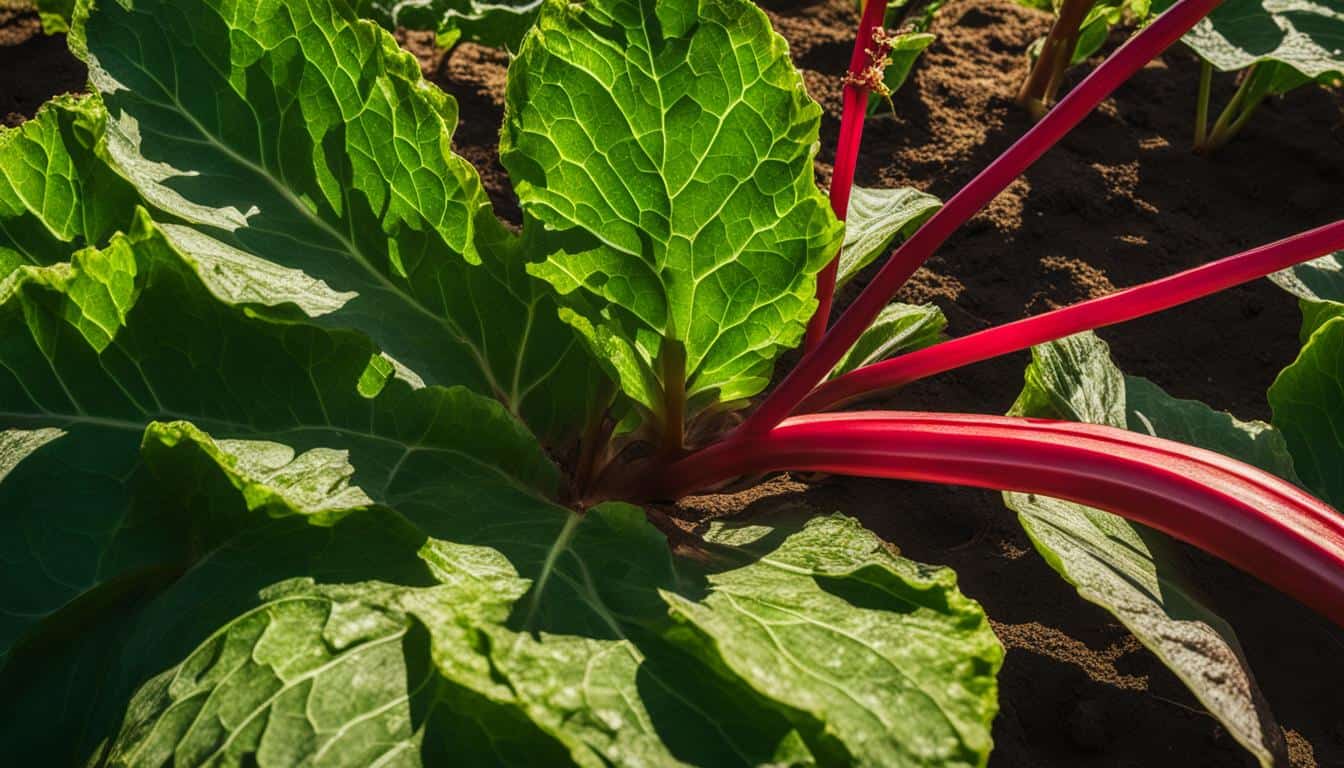Have you ever wondered if rhubarb is a fruit or a vegetable? This delightful plant has sparked a debate about its classification. Although it is commonly used as a fruit in culinary applications, rhubarb is actually a vegetable. Let’s explore the fascinating world of rhubarb and learn more about its classification, nutritional value, and culinary versatility.
Key Takeaways:
- Rhubarb is botanically classified as a vegetable, despite its common use as a fruit in cooking and baking.
- It is rich in essential nutrients, including vitamins K, C, and A, and is a good source of fiber.
- Rhubarb adds a tangy twist to both sweet and savory dishes, making it a versatile ingredient in the kitchen.
- It is important to remember that only the stalks of rhubarb are edible, as the leaves contain toxic compounds.
- Rhubarb is a seasonal vegetable, typically available in the spring and early summer months.
The Nutritional Value of Rhubarb
Rhubarb is a nutrient-dense vegetable that offers various health benefits. It is low in calories and fat, making it a great addition to a balanced diet. Rhubarb is an excellent source of vitamins, including vitamin K, vitamin C, and vitamin A. It also contains minerals like calcium. Additionally, rhubarb is rich in fiber, which aids in digestion and promotes gut health. Consuming rhubarb can contribute to a well-rounded and nutritious diet.
The Nutritional Value of Rhubarb
Rhubarb is a nutritional powerhouse that provides a range of vitamins and minerals essential for our health. Here’s a closer look at some of the key nutrients found in rhubarb:
- Vitamin K: Rhubarb is packed with vitamin K, which plays a crucial role in blood clotting and bone health.
- Vitamin C: This vitamin is known for its immune-boosting properties and is also involved in collagen production, wound healing, and iron absorption.
- Vitamin A: Rhubarb is a good source of vitamin A, which is important for maintaining healthy skin, vision, and immune function.
- Calcium: Rhubarb contains a decent amount of calcium, which is essential for strong bones and teeth.
- Fiber: Rhubarb is high in fiber, which helps regulate digestion, promotes feelings of fullness, and supports a healthy gut.
By incorporating rhubarb into your diet, you can enjoy these nutritional benefits and support your overall well-being.
| Nutrient | Amount per 100g |
|---|---|
| Vitamin K | 29.3 mcg |
| Vitamin C | 8.0 mg |
| Vitamin A | 102 IU |
| Calcium | 86 mg |
| Fiber | 1.8 g |
“Rhubarb is a nutritional powerhouse, packed with essential vitamins and minerals that contribute to our overall health and well-being.” – Nutritionist
With its impressive nutritional profile, rhubarb is a valuable addition to any diet. Whether enjoyed in pies, compotes, or savory dishes, rhubarb not only adds a unique flavor but also provides a host of health benefits. So, next time you’re in the mood for a tangy treat, don’t hesitate to reach for some delicious rhubarb.
The Difference Between Fruit and Vegetable
To understand the classification of rhubarb, we need to explore the difference between fruits and vegetables. Fruits are typically formed from the ovary of a flower and contain seeds. They are often sweet and juicy, enticing our taste buds with their natural sugars. Examples of fruits include apples, oranges, and strawberries. On the other hand, vegetables are the edible parts of plants that do not have seeds. They are categorized based on the part of the plant they come from, such as roots, stems, leaves, or flowers. Common vegetables include carrots, broccoli, and lettuce. So, how does rhubarb fit into this classification?
Rhubarb is technically a vegetable because it is the stalk of the plant that we consume, and it does not contain seeds. The stalks of rhubarb are thick, fibrous, and rich in nutrients. They are tart in flavor and have a vibrant red or green color, depending on the variety. Despite being classified as a vegetable, rhubarb is often treated as a fruit in culinary applications due to its taste and ability to complement sweet dishes. It is commonly used in pies, crumbles, and jams, where its tangy flavor adds a delightful contrast to the sweetness of other ingredients.
When it comes to the rhubarb debate, it’s important to remember that classification in the botanical sense doesn’t always align with culinary usage. While rhubarb may be a vegetable at heart, its versatility in the kitchen allows us to enjoy it as a fruit in many delicious recipes.
In summary, rhubarb may be classified as a vegetable, but its culinary usage often blurs the line between fruits and vegetables. Whether you consider it a fruit or a vegetable, what truly matters is the unique flavor and culinary possibilities it brings to our plates.
| Fruits | Vegetables |
|---|---|
| Apples | Carrots |
| Oranges | Broccoli |
| Strawberries | Lettuce |
Cooking with Rhubarb: Delicious Recipes
Rhubarb is not only a versatile ingredient but also adds a unique tangy flavor to various culinary creations. Whether you’re a fan of sweet desserts or savory dishes, there are plenty of delicious rhubarb recipes to try. Here are a few ideas to inspire your next cooking adventure:
Sweet Treats
One of the most popular ways to use rhubarb is in sweet desserts. From pies to crumbles, these recipes showcase the tartness of rhubarb in perfect harmony with sweet ingredients. Here’s a classic rhubarb pie recipe to get you started:
“The combination of juicy strawberries and tangy rhubarb is a match made in dessert heaven. Start by making a homemade pie crust, then fill it with a mixture of sliced rhubarb and strawberries. Add a touch of sweetness with sugar and a hint of warmth with cinnamon. Bake it until the crust is golden and the filling is bubbling. Serve it warm with a scoop of vanilla ice cream for a truly delicious treat.”
If you prefer a simpler option, try making a rhubarb crumble. Just toss chopped rhubarb with sugar and a squeeze of lemon juice, then top it with a buttery crumble mixture of oats, flour, and brown sugar. Bake until the rhubarb is tender and the topping is crispy. Serve it with whipped cream or a scoop of your favorite ice cream.
Savory Delights
While rhubarb is commonly associated with desserts, it can also be used in savory dishes to add a unique twist. Here’s a simple recipe for a rhubarb chutney:
“Combine diced rhubarb with onions, sugar, vinegar, and a pinch of spices like ginger and cinnamon. Simmer the mixture until the rhubarb is tender and the flavors have melded together. This tangy chutney pairs perfectly with roasted meats or can be spread on sandwiches for a burst of flavor.”
Another savory option is to make a rhubarb sauce to accompany grilled or roasted meats. Simply cook rhubarb with sugar, a splash of orange juice, and a pinch of salt until it breaks down into a thick sauce. The sweet and tangy flavor of the rhubarb sauce complements the richness of the meat, creating a delicious contrast of flavors.
Conclusion
There are countless ways to incorporate rhubarb into your cooking, whether you prefer sweet or savory dishes. From pies and crumbles to chutneys and sauces, the tart and tangy flavor of rhubarb adds a delightful twist to any recipe. So, grab some fresh stalks of rhubarb and get creative in the kitchen. Your taste buds will thank you!
Rhubarb: A Seasonal Delight

Rhubarb is a unique vegetable that delights our taste buds during the spring and early summer months. This vibrant plant thrives in cooler climates and offers a refreshing tartness that pairs perfectly with the arrival of warmer weather. The availability of rhubarb may vary depending on your location, but it is generally considered a seasonal delicacy that brings joy to culinary enthusiasts.
As a seasonal vegetable, rhubarb enjoys the spotlight when other fruits and vegetables are not yet in abundance. Its distinct flavor and vibrant appearance make it a popular choice for both sweet and savory preparations. Whether you’re indulging in a tangy rhubarb pie or incorporating it into a savory chutney, the seasonal nature of rhubarb adds a touch of excitement and anticipation to our plates.
For those who appreciate the beauty of nature’s cycles, growing rhubarb in your own garden can be a rewarding experience. It requires well-drained soil and plenty of sunlight, making it a perfect addition to a spring garden. Watching the plant go from dormant during the winter months to producing quality stalks in the spring is a testament to the wonders of nature and the joy of cultivating your own seasonal produce.
| Season | Availability |
|---|---|
| Spring | Abundant |
| Summer | Limited |
In conclusion, rhubarb is a seasonal delight that captivates our taste buds and adds a burst of flavor to our favorite dishes. Its availability during the spring and early summer months makes it a cherished ingredient in the culinary world. Whether you’re enjoying the fruit-like qualities of rhubarb in a sweet dessert or exploring its unique tanginess in a savory creation, the seasonality of rhubarb adds an extra layer of excitement to our meals.
Rhubarb Farming and Cultivation
When it comes to rhubarb farming and cultivation, there are a few key factors to consider in order to ensure a successful harvest. Rhubarb is a hardy plant that can be grown in various climates, but it thrives best in cooler regions. It requires well-drained soil and a good amount of sunlight to grow and develop properly.
When starting a rhubarb garden, it’s important to choose the right planting method. Rhubarb plants are typically started from crowns or divisions, which are sections of the mature plant. These can be planted in early spring or late fall, allowing enough time for the plants to establish themselves before the growing season begins. Each plant should be given enough space to grow and spread, as rhubarb plants can become quite large.
Regular watering is essential for the health of rhubarb plants. They should be watered deeply once a week, ensuring that the soil is thoroughly soaked. Occasional fertilization, using a balanced fertilizer, can also help promote healthy growth. Weeds should be regularly removed from the rhubarb bed to prevent competition for nutrients.
Harvesting rhubarb should be done by gently pulling the stalks away from the plant. It’s important to avoid damaging the crown, as this is where the new growth and future stalks will come from. Only the stalks of the rhubarb plant are edible, as the leaves contain toxic compounds and should never be consumed. With proper care and attention, you can enjoy a bountiful harvest of delicious rhubarb stalks from your own garden.
Rhubarb Planting and Care Guide
| Aspect | Requirements |
|---|---|
| Soil | Well-drained |
| Sunlight | Full sun to partial shade |
| Planting | Early spring or late fall |
| Spacing | 3-4 feet apart |
| Watering | Deep watering once a week |
| Fertilization | Occasional balanced fertilizer |
| Weeding | Regular removal of weeds |
| Harvesting | Gently pull stalks, avoiding damage to the crown |
Remember, rhubarb plants are perennial, meaning they will come back year after year. With proper care and attention, your rhubarb garden can be a source of delicious stalks for many seasons to come.
Rhubarb: A Culinary Staple in Yorkshire

In the picturesque region of West Yorkshire, England, rhubarb holds a special place in the culinary tradition. Known as the “Rhubarb Triangle,” this area is renowned for its high-quality rhubarb production. Farmers in the region have mastered the art of cultivating rhubarb in dark, candle-lit sheds to produce tender, sweet stalks. The forced rhubarb from Yorkshire is highly coveted and used in various traditional dishes and desserts, making it a true delicacy.
The unique growing environment and careful cultivation techniques in Yorkshire contribute to the exceptional quality of the rhubarb. The darkness of the sheds encourages the plants to grow long and tender stalks, while the candlelight ensures a consistent temperature. This process of “forcing” the rhubarb creates a more delicate and sweeter flavor compared to rhubarb grown in open fields. The result is a sought-after ingredient that adds a touch of sophistication and authenticity to Yorkshire’s culinary creations.
“The forced rhubarb from Yorkshire is highly sought after and is used in various traditional dishes and desserts. It is considered a delicacy and plays a significant role in the local food culture.”
The fame of Yorkshire rhubarb extends beyond the region, with chefs and food enthusiasts across the world seeking out this exceptional ingredient. The vibrant pink stalks of Yorkshire rhubarb add a visually appealing element to any dish, while their tender texture and unique sweetness elevate the overall flavor profile. Whether it’s used in pies, crumbles, compotes, or even savory dishes, Yorkshire rhubarb brings a touch of culinary distinction to every plate.
Cooking with Yorkshire Rhubarb
When it comes to cooking with Yorkshire rhubarb, the possibilities are endless. Its natural tartness adds a delightful tang to both sweet and savory dishes, making it a versatile ingredient in the kitchen. From classic rhubarb pies and crumbles to innovative recipes like rhubarb chutneys or rhubarb-infused cocktails, the creative potential is boundless. The unique flavor and tender texture of Yorkshire rhubarb make it a favorite among chefs and home cooks alike, inspiring culinary experimentation and the creation of unforgettable dishes.
To truly appreciate the culinary wonders of Yorkshire rhubarb, one must experience its exceptional flavor firsthand. Whether you have the opportunity to taste the regional delicacy in Yorkshire itself or explore the diverse recipes it inspires, the allure of Yorkshire rhubarb is sure to leave a lasting impression on your taste buds. So embrace the culinary traditions of Yorkshire and savor the unique delights of this exceptional ingredient.
The Culinary Versatility of Rhubarb
When it comes to cooking with rhubarb, the possibilities are endless. This versatile ingredient can add a tangy twist to both sweet and savory dishes, bringing a unique flavor profile to your culinary creations. Rhubarb’s tartness pairs perfectly with sweet ingredients like strawberries and apples, making it a popular choice for pies, crumbles, and compotes. But its versatility doesn’t stop there. Rhubarb can also be used to make sauces, jams, and even cocktails, adding a refreshing and tangy kick to your favorite beverages.
The bright pink color of cooked rhubarb not only adds visual appeal to your dishes but also serves as a reminder of the vibrant flavors that await. Whether you’re using it as a topping for yogurt or ice cream, incorporating it into a salad dressing, or experimenting with it in a savory chutney or sauce, rhubarb is sure to bring a burst of flavor to any recipe.
One of the delights of cooking with rhubarb is its unique texture. When cooked, the stalks become tender, while still retaining a slight firmness, giving your dishes a delightful bite. This texture allows rhubarb to hold its shape well in pies and tarts, adding both flavor and aesthetic appeal to your desserts.
Rhubarb Recipes
Ready to explore the culinary possibilities of rhubarb? Here are a few delicious recipes to get you started:
- Strawberry Rhubarb Pie: The classic combination of strawberries and rhubarb comes together in this delightful pie. The sweet and tart flavors meld perfectly, creating a dessert that is both refreshing and indulgent.
- Rhubarb Chutney: This tangy chutney is the perfect accompaniment to grilled meats or cheese boards. The combination of rhubarb, onions, spices, and a touch of sweetness creates a versatile condiment that adds a burst of flavor to any dish.
- Rhubarb Ginger Cooler: Beat the summer heat with this refreshing beverage. The combination of rhubarb, ginger, and sparkling water creates a crisp and invigorating drink that is both thirst-quenching and full of flavor.
So, why not unleash your creativity in the kitchen and start experimenting with rhubarb? Its culinary versatility is sure to inspire you to create new and delicious dishes that will impress your family and friends.
Exploring the Rhubarb Garden

Rhubarb cultivation in your own garden can be a rewarding experience. As a resilient plant, rhubarb requires some basic care and attention to thrive. Here are some steps to get started:
Choosing the Right Spot:
Find a sunny spot in your garden with well-drained soil. Rhubarb plants prefer at least six hours of direct sunlight each day. It’s important to ensure that the soil drains well to prevent waterlogging, as excessive moisture can lead to root rot.
Planting Rhubarb:
Plant rhubarb crowns or divisions in early spring or late fall. Dig a hole that is slightly deeper than the crown and wide enough to accommodate the roots. Space each plant at least three feet apart to allow for their growth and to avoid competition for nutrients. Place the crown in the hole and cover it with soil, making sure the buds are positioned facing upward.
Maintaining Rhubarb:
Once planted, regular watering is necessary to keep the soil moist but not saturated. Avoid overwatering, as it can lead to root rot. Mulching around the plants can help retain moisture and suppress weed growth. Fertilize rhubarb plants in the early spring and again in late summer or early fall with a balanced organic fertilizer. Remove any weeds that may compete with the plants for nutrients.
Harvesting Rhubarb:
Rhubarb plants typically require two to three years to establish before they can be harvested. During this time, it’s important to resist the temptation to harvest the stalks and allow the plants to develop a strong root system. When the stalks are about 10-12 inches long and firm, they are ready to be harvested. Gently pull the stalks away from the base, taking care not to damage the crown.
With proper care and attention, you can enjoy a bountiful harvest of rhubarb stalks in your own backyard. Whether you use them in pies, jams, or other culinary creations, the joy of growing your own rhubarb is a delightful addition to any garden.
The Culinary Curiosity of Rhubarb
The classification of rhubarb as a vegetable, despite its culinary usage as a fruit, adds a layer of curiosity to its presence in our kitchens. The fact that the stems of rhubarb are edible while the leaves are toxic showcases the complexity of this plant. The tart and tangy flavor of rhubarb provides a unique contrast to the sweetness of fruits and adds depth to various dishes. Whether you consider it a fruit or a vegetable, there is no denying the culinary curiosity that rhubarb brings to the table.
The Versatile Rhubarb: A Vegetable with a Sweet Twist
Rhubarb, often mistaken as a fruit, is a vegetable that surprises the taste buds with its tart and tangy flavor. Despite being classified as a vegetable, it is used in cooking and baking as if it were a fruit. The culinary versatility of rhubarb is what makes it a curiosity in the kitchen.
“Rhubarb is a peculiar plant that blurs the line between fruit and vegetable,” says Chef Jane Smith, renowned pastry chef and food blogger.
“Its vibrant pink stalks add a pop of color to desserts, while its tartness balances out the sweetness in pies and crumbles. It’s fascinating how this vegetable can mimic the characteristics of a fruit in so many delicious ways.”
Whether it’s a classic rhubarb pie or a rhubarb-strawberry sauce drizzled over vanilla ice cream, rhubarb never fails to intrigue the taste buds. Its unique flavor profile makes it a staple in both sweet and savory dishes, defying traditional categorization and inviting culinary exploration.
| Rhubarb as a Vegetable | Rhubarb as a Fruit |
|---|---|
| Rhubarb belongs to the vegetable classification due to its growth characteristics and lack of seeds. | Rhubarb is often used like a fruit in cooking and baking due to its tart flavor and culinary applications. |
| Rhubarb stalks are edible and can be used in various recipes. | Rhubarb stalks can be cooked, sweetened, and used in pies, tarts, and other desserts. |
| The leaves of the rhubarb plant are toxic and should never be consumed. | The vibrant pink color of rhubarb stalks adds visual appeal to dishes. |
Conclusion
In conclusion, rhubarb is an intriguing plant that blurs the line between fruit and vegetable. While it is commonly used in culinary applications as a fruit, botanically it is classified as a vegetable. This unique classification adds to the culinary curiosity that surrounds rhubarb.
Despite its classification, rhubarb offers a range of health benefits and can be a fantastic addition to various dishes. Its tart flavor and vibrant color make it a versatile ingredient that can enhance both sweet and savory recipes. Whether you incorporate rhubarb into pies, chutneys, or compotes, its unique culinary appeal is undeniable.
So, if you’re looking to add a touch of tanginess to your cooking, don’t hesitate to explore the possibilities of cooking with rhubarb. From traditional recipes to inventive creations, rhubarb can be a delightful ingredient that adds a burst of flavor to your culinary adventures.
FAQ
Is rhubarb a fruit or a vegetable?
Rhubarb is botanically classified as a vegetable, although it is commonly used as a fruit in culinary applications.
What are the health benefits of rhubarb?
Rhubarb is low in calories and fat, and it is an excellent source of vitamins, minerals, and fiber. It can contribute to a well-rounded and nutritious diet, aid digestion, and promote gut health.
What is the difference between fruits and vegetables?
Fruits develop from the ovary of a flower and contain seeds, while vegetables are the edible parts of plants that do not have seeds. Rhubarb is a vegetable because it does not have seeds, even though it is often used in sweet dishes due to its tart flavor.
How can I cook with rhubarb?
Rhubarb can be used in a variety of culinary preparations. It is commonly used in sweet dishes such as pies, crumbles, and compotes. It can also be incorporated into savory dishes like chutneys or sauces to add a tangy taste.
When is rhubarb in season?
Rhubarb is most commonly available in the spring and early summer months. It thrives in cooler climates and is often harvested when other fruits and vegetables are not yet in season.
How do I grow rhubarb?
Rhubarb prefers well-drained soil and requires a good amount of sunlight to thrive. It is typically started from crowns or divisions and can take several years to establish before producing a bountiful harvest. Regular watering, occasional fertilization, and proper spacing are necessary for healthy growth.
Why is rhubarb important in Yorkshire, England?
The region of West Yorkshire, England, is known as the “Rhubarb Triangle” and is famous for its high-quality rhubarb production. Forced rhubarb from Yorkshire, grown in candle-lit sheds, is highly sought after and plays a significant role in the local food culture.
What can I make with rhubarb?
Rhubarb can be used to make a variety of dishes, including pies, crumbles, sauces, jams, and even cocktails. Its tart flavor pairs well with strawberries, apples, and ginger, allowing for delicious and creative culinary creations.
How do I grow rhubarb in my own garden?
Choose a sunny spot in your garden with well-drained soil. Plant rhubarb crowns or divisions in early spring or late fall, giving each plant enough space to grow. Regular watering, fertilization, and occasional weeding are necessary for healthy plants and a bountiful harvest.
What makes rhubarb a culinary curiosity?
Rhubarb’s classification as a vegetable despite its culinary usage as a fruit adds an element of curiosity to its presence in our kitchens. Its toxic leaves and edible stalks showcase the complexity of this plant, and its tart flavor adds a unique contrast to various dishes.





Leave a Reply